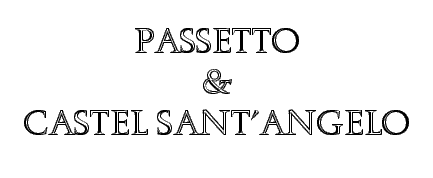
| The first place we visited on this trip was a spread out
"place," the wall which runs from the Vatican Papal residence
to Castel Sant' Angelo on the Tiber River. Through history
there's been few protective walls around the Vatican. The Vatican
was situated inside the 3d century AD Aurelian Walls but those provided
little security when the Muslims invaded in 846 and sacked the Vatican
and defiled the Apostle's Grave. This event is glossed over by
modern-day Muslims in their rants about the Crusades of the 11th
century. Pope Nicholas III had the present wall built between the
Vatican and Castel Sant'Angelo. Shortly thereafter, the papal
court was removed to Avignon, France, where it remained until
1377. When it returned, the wall was renovated along with the rest
of St. Peter's Basilica.
One element in the wall from the beginning is a narrow passageway near the top which allows someone to walk in relative secrecy and safety the length of the wall. It was designed as an emergency escape route. The only time in history when it was used for that purpose was on May 6, 1527. Pope Clement VII found Rome encircled by the advancing armies of the Holy Roman Emperor Charles V. The army, composed of German Protestants and some mercenary Spaniards had not been paid for a while and were in an ugly mood. Since they had no love for Catholics anyhow, the army forced its commander to sack Rome. Clement VII proposed staying on the papal throne and staring them down but was urged by the Cardinals to flee to safety. Should he be killed, they argued, the Church might cease to exist. Clement could hear the sounds of the advancing army as it entered the Church-run Hospital San Spirito and all the patients were pulled from their beds and butchered on the spot. Clement, escorted by a Swiss Guardsman and a Cardinal used Il Passetto and raced toward Sant' Angelo. The passageway is only wide enough for one person with almost no room to even turn around. As they entered, they heard the sounds of the Swiss Guard engaging the invaders. That day 147 of the 189 Swiss Guards died in battle defending the Vatican. During the rest of the journey down the passageway, they were exposed to the sounds of convent nuns being raped and massacred and priests being decapitated. Back in the Vatican, the invaders looted and destroyed, even opening the sarcophagi of past popes in their search for valuables and desecrating the bodies. Not exactly ecumenism's finest day. |
|
|
|
The Passetto begins at the Vatican at the barracks of the Swiss Guard. The duty sergeant keeps on his person the key to the entrance during his tour of duty. |
|
|
|
Immediately the wall is penetrated by the street leading from St. Peter's Square to the Port Angelica gate. |
|
|
|
This is not a pedestrian-only zone............just a bunch of gutsy pedestrians. |
|
|
|
The wall is about 30 feet high up to the battlement walkway at the top. The narrow slits provide illumination for the Passetto inside. |
|
|
|
The wall with the Passetto continues down the street through the Borgo District. |
|
|
|
The wall (and the Passetto) run a total of about 800 meters down to Sant'Angelo. |
|
|
|
It just keeps going. |
|
|
|
At this point, we're getting close to the Tiber. |
|
|
|
On the other side of the street, the wall becomes a bridge over the Tiber. |
|
|
|
On the far left side, you can see the wall connecting into the wall of Castel Sant'Angelo. |
|
|
|
Castel Sant'Angelo was built by the emperor Hadrian as a mausoleum for him and his family in 135 AD. Soon after Christianity was legalized in the early 4th century, ownership was given to the Church. Over the centuries, it has been used as a fortress, a papal residence, and a prison. It was also the backdrop for the third act of the opera Tosca by Puccini. |
|
|
|
Castel Sant' Angelo is built on a bend in the Tiber. This is the pedestrian Ponte Sant' Angelo crossing the river north to south. |
|
|
|
This picture was taken from the Ponte Sant' Angelo looking down on the peripheral road along the river. Straight ahead in the background is St. Peter's Basilica. |
|
|
|
Sant' Angelo is a tourist attraction so the whole freak show was there the day we were. In addition to the faux Roman soldiers, there was the Invisible Man, several live tableaus, walking ghosts, and so many other forgettable characters. |
|
|
|
Sant' Angelo got its present name from an apparition witnessed by many people in 590 AD. The bubonic plague had just run its course in Rome and a sizable percentage of the city succumbed to it. The Archangel St. Michael was seen hovering above Hadrian's Mausoleum in the act of sheathing his sword, indicating the end of the plague. Sculptors designed the statue atop the building based on the descriptions of what the witnesses claim to have seen. |